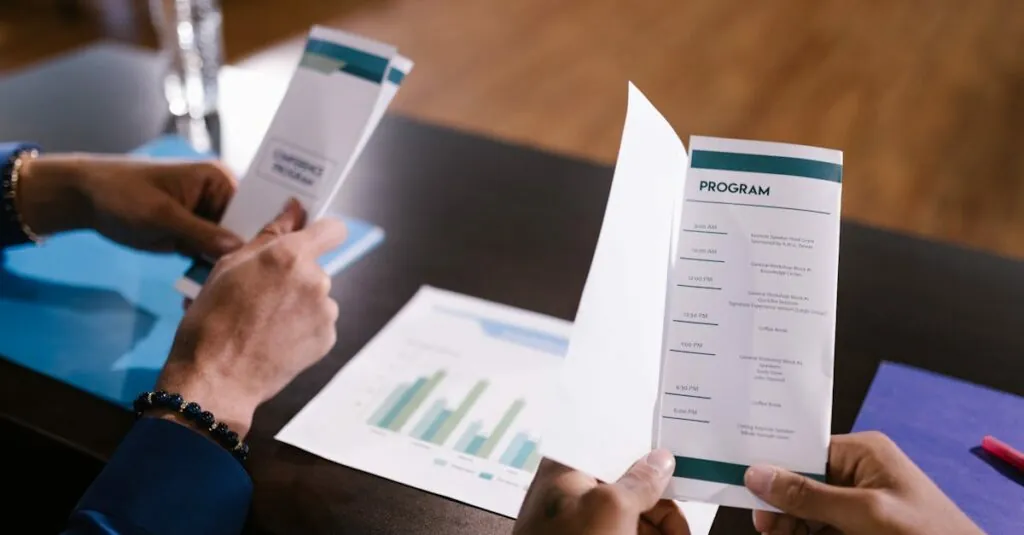In a world where gadgets seem to age faster than a fine cheese, trade-in programs have emerged as the savvy consumer’s best friend. Who wouldn’t want to turn that dusty old smartphone or outdated gaming console into cash or credit? It’s like finding a $20 bill in your winter coat—unexpected and delightful.
Table of Contents
ToggleOverview of Trade-In Programs
Trade-in programs have gained traction as consumers seek ways to exchange older devices for monetary value. Participants can receive cash or store credit, making this option appealing in a tech-driven market. Value assessments often determine the trade-in amount, which varies based on device condition and model popularity.
Devices accepted in trade-in programs include smartphones, tablets, laptops, and gaming consoles. Participating retailers and manufacturers frequently outline their specific criteria and processes. For example, a retailer might offer instant trade-in values through online calculators that consider the device’s age and functionality.
Additionally, environmental benefits accompany the trade-in process. By exchanging old devices, users contribute to reduced electronic waste. Recycled materials can often be utilized in new gadgets, promoting sustainable consumer habits.
Many trade-in programs incorporate easy submission methods. Online platforms allow users to submit requests, while retail locations offer in-person evaluations. Convenience plays a significant role in attracting consumers towards these programs.
Trade-in program reviews highlight the diversity of options available. Some reviews emphasize faster transactions, while others focus on the highest payouts. Price comparison among various programs ensures customers maximize their returns.
Trade-in programs present a convenient solution for consumers. They foster savings, promote sustainability, and simplify the transition to new technology. Through detailed evaluations and transparent processes, individuals receive tangible benefits from their unused gadgets.
Benefits of Trade-In Programs
Trade-in programs offer numerous advantages for consumers ready to exchange their old devices. These benefits include significant financial incentives and positive environmental impacts.
Financial Incentives
Retailers provide cash or store credit based on the model and condition of the device. For instance, a well-maintained smartphone might yield up to $500, while a gaming console could return around $300. This exchange allows consumers to offset the cost of new technology. Instant assessments streamline the process, delivering quick gratification. Various platforms and retailers now exist, encouraging comparison shopping for optimal returns. Overall, these financial boosts contribute to smarter purchasing habits.
Environmental Impact
Trade-in programs significantly reduce electronic waste, which poses a major environmental challenge. Recycling old devices through these programs contributes to resource conservation and less landfill runoff. With millions of smartphones and other gadgets discarded annually, each trade-in helps alleviate pressure on natural resources. Moreover, many retailers partner with recycling firms to ensure responsible handling of outdated devices. Embracing trade-ins promotes sustainable consumer behaviors and underscores environmental responsibility within technology markets.
How Trade-In Programs Work
Trade-in programs allow consumers to exchange old devices for cash or credit, streamlining the upgrade process. Understanding eligibility and the valuation process helps maximize benefits from these programs.
Eligibility Criteria
Retailers generally accept various devices, including smartphones, tablets, laptops, and gaming consoles. Each program provides specific requirements based on brand, model, and device condition. Working condition significantly influences eligibility; functional devices earn higher valuations. Condition assessments include factors like screen quality, battery health, and overall usability. Customers benefit from reviewing individual store policies, ensuring compliance with stated guidelines. This attention to detail enhances traders’ opportunities for successful transactions.
Valuation Process
The valuation process involves assessing a device’s condition and market demand. Retailers often provide online tools for preliminary estimates, simplifying valuation for consumers. Assessors consider factors such as age, model popularity, and wear-and-tear indicators. Typically, higher demand devices yield increased offers while less popular models may return lower values. Transparency in valuation helps users understand pricing. Many retailers revise their offers based on real-time sales trends, ensuring competitive pricing. This process ensures fair exchanges while promoting informed decisions among consumers.
Comparison of Popular Trade-In Programs
Consumers can choose from various trade-in programs that offer competitive returns on their old devices. Each program has unique features, payout structures, and conditions, making comparison crucial for maximizing benefits.
Program A Review
Program A provides a streamlined trade-in experience for smartphones and tablets. It evaluates device condition through an easy online assessment tool that offers instant quotes. Accepted models span multiple brands, ensuring broad compatibility. Payout amounts can reach up to $400 for high-condition devices. Customers appreciate the quick turnaround, with payments processed within 7 days of device receipt. Transparency in their pricing methods encourages trust among users.
Program B Review
Program B focuses on gaming consoles and accessories, catering to avid gamers looking to upgrade. This program stands out for offering promotional bonuses during peak seasons, which can add significant value. Users can expect straightforward evaluations based on device functionality and appearance. Return values can soar as high as $300 for well-preserved consoles. Program B’s customer support receives positive feedback for its helpfulness and responsiveness, enhancing overall user satisfaction.
Program C Review
Program C targets a wide range of electronics, including laptops and smartwatches. With a user-friendly interface, this program allows customers to track the trade-in process via a mobile app. Valuations reflect current market trends, providing competitive returns. Customers can earn up to $500 for premium laptops in excellent condition. Additionally, this program highlights its commitment to environmental sustainability by recycling devices responsibly, a feature that resonates well with eco-conscious consumers.
Trade-In Program Best Practices
Selecting the right trade-in program requires careful consideration of best practices. First, assess the condition of the device thoroughly. Factors such as screen quality and battery health play significant roles in valuation.
Second, conduct research on multiple programs. Comparing payout amounts and processing times helps maximize returns. Each retailer offers unique benefits that can influence the decision.
Third, gather all relevant accessories. Including items like chargers and original packaging can enhance the trade-in value. Programs sometimes offer higher payouts for complete sets.
Fourth, consider timing for trade-ins. Market demand often fluctuates, affecting the value of specific devices. Trading in high-demand electronics when they’re still popular typically yields better returns.
Additionally, check for promotional bonuses. Many programs run special campaigns that provide extra value or bonuses. Staying informed about these offers can significantly increase savings.
Seek out online tools for preliminary estimates. Many retailers provide calculators that give potential values based on device condition. Using these tools facilitates better decision-making.
Finally, understand the terms and conditions of each program. Knowing specifics about payout timelines and processing fees prevents unexpected surprises. Evaluating these details empowers consumers to make informed decisions regarding their trade-in options.
These best practices enhance the trade-in experience, ensuring consumers receive optimal value for their devices while fostering environmentally conscious choices.
Conclusion
Trade-in programs offer a valuable opportunity for consumers to turn old gadgets into cash or credit while promoting sustainable practices. By understanding the various options available and following best practices, individuals can maximize their returns and make informed decisions. The financial incentives and environmental benefits of these programs make them an attractive choice in today’s tech-driven world. As technology continues to evolve, trade-in programs will likely remain a convenient and responsible way to upgrade devices while reducing electronic waste. Embracing these programs not only enhances personal savings but also contributes to a more sustainable future.





